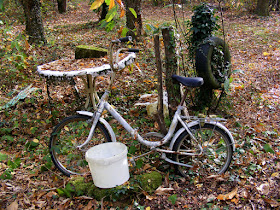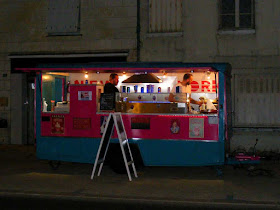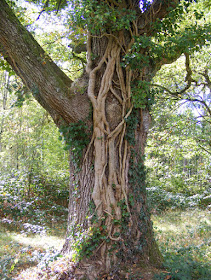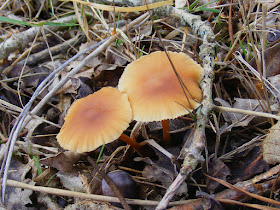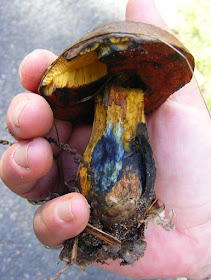The étang is dry.
One morning about 10 days ago my friend André rang me up. He asked me if Simon and I were free the next afternoon (we were). So we were invited to a small gathering at André's secret woodland hideaway, where we would roast chestnuts and drink cider, in the spirit of the season.
The waterlilies are an ornamental species, not native, but there is barely enough water to keep them alive this year.
He sent me instructions by email for how to get there and then corrected my French when I replied (I'd used était where I should have used serait, although there was a bit of discussion about whether it should actually have been soit...) Our mutual friend Jean and his wife Maggy would be coming, as well as André's partner Louisette.
André has built himself a hide.
Years ago André bought a parcel of woodland with a large manmade pond called an étang in the centre. It's about 20 minutes from where he lives and about half way between his place and ours. Over the years he's had fun with his various diggers and earthmoving equipment creating holes, mounds and tracks. There is a caravan, permanent awning and barbecue on an island in the middle of the étang. You access it by a high bridge with wire sides so you don't fall several metres into the drink.
André wrangles chestnuts at the barbecue whilst Jean and the rest of us wait patiently.
Mambo the 18 month old Rhodesian Ridgeback was delighted to have extra company. He is very tall and hasn't yet learnt to sit quietly under the table when people are eating.
Louisette and Maggy.
I really liked the low key way everyone dealt with Mambo. He's a big dog and doesn't yet understand that he is encroaching on people's personal space. Nobody made a fuss. He wasn't harshly disciplined, but he wasn't rewarded with excessive attention either. Reward good behaviour and ignore bad is a relaxed and sensible way to deal with Ridgebacks.
I also really enjoyed the fact that no one fussed when Mambo interacted with me. I like dogs and am perfectly capable of dealing with an enthusiastic hound. I don't mind owners who check with me about how I am with dogs on first meeting, but I get frustrated by owners who continually keep their dogs away from guests and spend all their time fussing about what the dog is doing.
One reason I enjoyed the company of young Mambo is that I owned a Ridgeback myself in my twenties and thirties. I know what they are like and would recommend them to anyone who likes hunting dogs.
André has offered his place as a venue for one of our monthly apéro or picnic gatherings, so I think in the late spring or summer we will organise it.
Come on! I thought we were going for a walk!!
Mambo has the most remarkably springy step, like a prancing thoroughbred and is still prone to mad puppy fits of bouncing around, tearing up and down or wrestling sticks.
No, I have no idea why there is a table with a decaying table cloth next to a folding bicycle...












